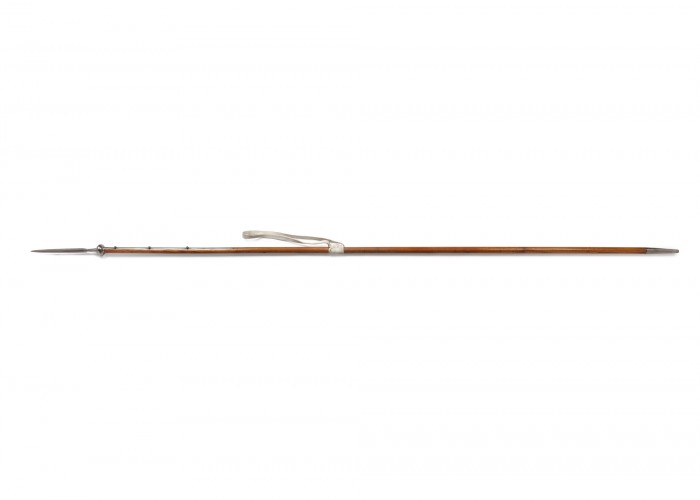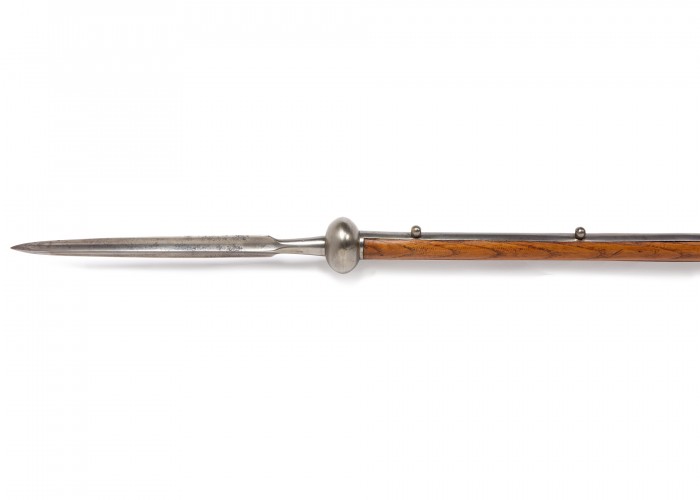Cavalry Lance
This is a cavalry lance, much like those carried at the Battle of Waterloo by soldiers of the French Army. Its long reach allowed a soldier on horseback to stab an enemy cavalryman before his sword could reach the lancer. The British were so impressed by the deadly effectiveness of the French lancers at Waterloo that they immediately began to equip some British cavalrymen with lances. This example is a British lance from 1821.
Lances were carried in the French Army by ordinary soldiers (other ranks) of the Polish and Dutch Lancers of the Imperial Guard, the Chevaux Legers (Light Horse) and the Eclaireurs (Scouts). All these units were light cavalry whose job was to find out where the enemy was, give warning if enemy soldiers were coming, attack the enemy’s supplies and harass enemy troops who were running away. They were completely different from other soldiers on horseback, the heavy cavalry, who would attack the enemy and break up his units by either killing them or forcing them to flee.
The first lancers were raised in the French army in 1807. Napoleon Bonaparte was so impressed with some Polish soldiers he saw armed with lances that he decided to arm French horsemen with the weapon. The length of the lance gave the soldier the ability to stab his foes at a longer distance than he could with a sword. This made the lancer greatly feared.
The lance is 275cm long and its shaft is made of hardwood such as ash or deal. The bottom has a steel ‘shoe’ to protect the wood when the lance was rested on the ground. The centre of the shaft has a whitened leather grip and a loop for the fingers called a martingale. The lance was decorated with a small red and white flag called a pennon. The steel point was made with a flattened diamond section which allowed it to easily penetrate an enemy soldier’s body. It is secured by long steel straps called langets which made it harder to chop off the point with a sword.
Not all the soldiers in a lancer regiment carried the lance. It was confined to those who were in the front rank. Soldiers in other ranks carried swords, pistols and short muskets called carbines.
According to tradition Major-General Sir William Ponsonby was killed by a French lancer at Waterloo when his horse became stuck in the mud.
The British artillery Captain Alexander Cavalie Mercer recalls an encounter with a badly wounded veteran French Lancer after the Battle of Waterloo. The old soldier thanked Mercer for a drink of water and paid great tribute to the steadiness and determination of the British troops during the battle. This so impressed Mercer that he asked to be allowed to take the man’s lance as a memento. The dying lancer was very pleased that his treasured weapon would go to another brave soldier rather than be stolen by Belgian peasants looting the dead and wounded.
The British were so impressed by the capabilities of the French lancers that they created their own lancer regiments from 1816 onwards.
-
Curatorial info
- Originating Museum: National Army Museum
- Accession Number: NAM. 1968-10-4-10
- Production Date: 1821
- Creator: Hardwood, steel
-
Use this image
You can download and use the high resolution image under a Creative Commons licence, for all non-commercial purposes, provided you attribute the copyright holder.
- Rights Holder: National Army Museum. Photography Relic Imaging Ltd.
- License Type: Creative Commons
Find it here
This object is in the collection of National Army Museum










